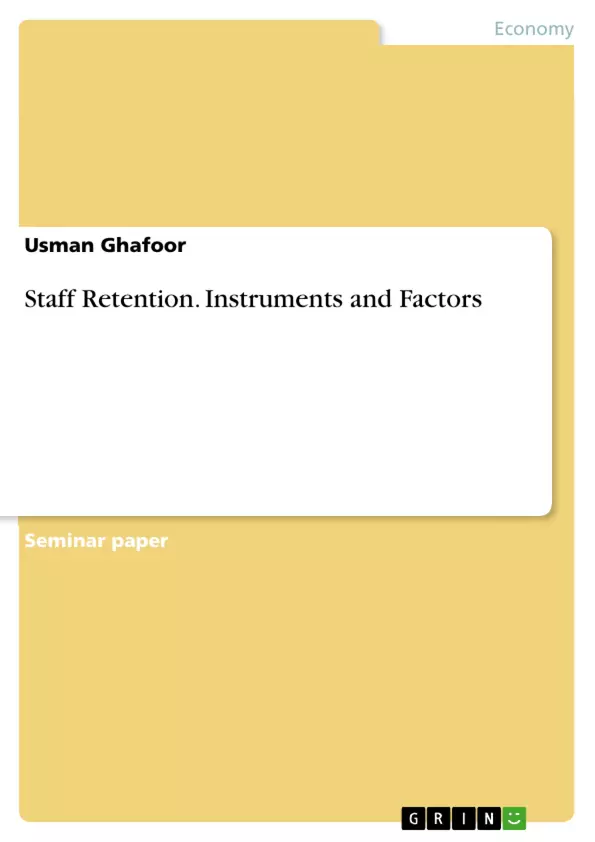This paper has the goal to analyze the issue staff retention. It subdivides in five chapters.
In the first chapter the problems of non-available staff retention and the goal of the paper are described.
The second chapter begins with the definition of the term staff retention. Following this the objectives of staff retention in companies and which reasons the companies have to implement the staff retention are described.
In the third chapter the instruments of commitment are described and the target which companies want to retain the employees for example with material or immate-rial inducements.
In the fourth chapter the factors which lead to staff retention are elucidated. To these factors belong the employee satisfaction, the connectedness and the restriction of employees to their company and the study of the satisfaction gap of employees.
The last chapter describes the important results of the paper, an overview of staff retention in the future and last but not least the conclusion of this paper.
Inhaltsverzeichnis (Table of Contents)
- Introduction
- Definition of the problem
- Purpose of the Study
- Structure
- Staff Retention
- Definition
- Objectives
- Measures of staff retention
- Instruments of staff retention
- Tangible binding instruments
- Mixed tangible / intangible binding instrument
- Intangible binding instruments
- Factors of staff Retention
- Employee satisfaction
- Employee connectedness
- Employee restriction
- Employee satisfaction gaps
Zielsetzung und Themenschwerpunkte (Objectives and Key Themes)
This paper aims to analyze staff retention in companies, exploring the methods, strategies, and tools used to retain employees, particularly highly qualified ones. It aims to showcase the economic benefits of investing in retention management and to present a successful staff retention strategy that aligns with both business philosophy and economic perspectives.
- The significance of staff retention in today's business environment, characterized by competitive pressure, skill shortages, and the challenges of demographic change.
- The different perspectives on staff retention, encompassing both the company’s and the employee’s viewpoints.
- The various instruments and factors contributing to staff retention, encompassing tangible and intangible incentives, employee satisfaction, connectedness, and restriction.
- The impact of staff retention on various business objectives, including increased profitability, reduced fluctuation, and improved productivity.
- The importance of employee satisfaction and addressing employee satisfaction gaps to achieve successful staff retention.
Zusammenfassung der Kapitel (Chapter Summaries)
The first chapter introduces the challenges of non-available staff retention and outlines the study's purpose and structure. The second chapter defines staff retention and explores its objectives, outlining the reasons for companies to implement retention management and the long-term benefits of retaining employees.
The third chapter delves into the instruments of employee commitment, categorizing them into tangible, mixed tangible/intangible, and intangible binding instruments. It explores various tangible incentives like salary increases and benefits, mixed incentives such as training programs, and intangible incentives like corporate culture and work climate.
The fourth chapter analyzes the factors that contribute to staff retention, including employee satisfaction, connectedness to the company, restriction from leaving, and satisfaction gaps. It explores various reasons behind employee connectedness and restriction, highlighting the importance of understanding and addressing employee needs.
Schlüsselwörter (Keywords)
The main keywords and focus topics of this paper include staff retention, employee loyalty, employee satisfaction, employee connectedness, employee restriction, tangible and intangible incentives, corporate culture, work climate, demographic change, competitive pressure, skill shortages, and the economic benefits of retention management.
- Quote paper
- Usman Ghafoor (Author), 2015, Staff Retention. Instruments and Factors, Munich, GRIN Verlag, https://www.grin.com/document/305229



